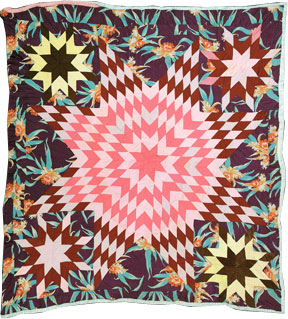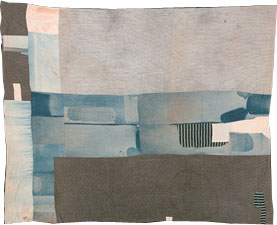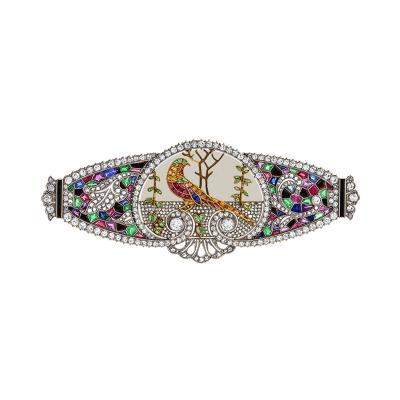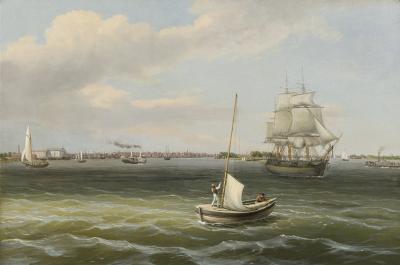The Quilts of Gee's Bend
Since the mid-1920s a group of exceptional women from the small town of Gee’s Bend, Alabama, have created hundreds of quilt masterpieces for their homes and families. The quiltmakers of this rural black community of about 700 have built on a tradition that undoubtedly extends back many generations, though earlier examples no longer survive. The Gee’s Bend quilts represent only a portion of the rich tradition of African-American quiltmaking in the South, but few other places can boast the density of Gee’s Bend’s artistic achievement, which is the result both of geographical isolation and an unusual degree of cultural continuity. Though the quiltmakers of this generation are decreasing in number, in few other places can we find surviving examples of work by three and sometimes four generations of women in the same family, or trace the lineages of different community quilting groups. And in few places can we find so many quilts with so much flair, pieced in bold, improvised geometric designs from salvaged work clothes and dresses, cotton sacks, and fabric samples.
The Quilts of Gee’s Bend exhibition at the Museum of Fine Arts, Houston, explores these expressive objects and the community in which they were made. The study owes its inception to the visionary efforts of collector William Arnett. Some thirty years ago, Arnett began collecting African art and then African-American vernacular art. He devoted all of his efforts and resources to researching, documenting, and supporting the art and artists of the African-American South.2 During the last ten years Arnett began to explore the African-American quilt tradition, which ultimately led to Gee’s Bend, this remote area of Alabama, and the documentation of over 700 quilts that expand the definition of contemporary art.3
This exhibition is much more than a collection of quilts. It is a study of a geographical area in need of documentation. Complementing and strengthening the surveys of black quilting traditions completed in the past two decades by scholars such as Maude Wahlman, Roland Freeman, Cuesta Benberry, Eli Leon, Marsha MacDowell, and others, this study presents those specific aspects of creativity, family, and community that define Gee’s Bend. The focus on this small town and its giant outpouring of creativity enables us to consider yet again the richness of African-American heritage throughout the United States.
Full comprehension of the quilts of Gee’s Bend, however, first requires an understanding of the community and its people and their ongoing struggle to survive. In his watershed book The Souls of Black Folk, W. E. B. Du Bois said of Georgia during his Southern travels in 1903, “How curious a land is this—how full of untold story, of tragedy and laughter and the rich legacy of human life; shadowed with a tragic past and big with future promise.”4 Du Bois could have just as easily been referring to Gee’s Bend as the Georgia hamlets he visited. For Du Bois the sociologist, the documentation of the post-Reconstruction black community in the South focused on the lack of educational opportunities for black children and the lack of avenues for real earning power for black men. For Du Bois the cultural historian, the African-American spiritual—the original music of the black South, in which the voices of both black men and women could be heard—gave a continual lift to his heart. The study of these quilts is, in a very real sense, an extension of Du Bois’s keen awareness and deep appreciation of a unique black art form, the spiritual or sorrow song. The women whose voices he heard in tiny rural churches throughout the South were also the women who often went back to their modest homes and created quilts for their burdened families.
As in most rural black communities, the church in Gee’s Bend has historically played a crucial role; it was one place where African-American men and women could openly congregate. For the women, church was a central social setting where they could exchange information and share ideas about cooking, singing, quilting, sewing, or keeping a home. Within the structure of the church in Gee’s Bend, a strong sense of music serves as a fundamental expression of individuality and spirituality. The importance of music in this community cannot be emphasized enough. Music moves from porch to porch and punctuates any ceremony, large or small, held in Gee’s Bend. When describing their lives, the women of Gee’s Bend frequently indicate that their most important hobby is their music. Like music, quiltmaking is an affirming performance, a great colorful subtext providing a vibrant visual framework for the community.
In Gee’s Bend, the creation of a quilt was and is a respite from the endless chores of daily living. The quilt was a “cushion,” in a very real sense of the word, enveloping and protecting families from the damp Alabama River air. The complexity of women’s lives, woven into a daily experience that included raising children, farming, and finally quilting, is reflected in the complexity of their quilt compositions. Just as it became second nature for singers within the community to experiment with notes, so too did quilters become comfortable when straying into uncharted territory, producing compositions quite unlike the norms of American quiltmakers.
Indeed, the Gee’s Bend aesthetic is as inventive as the town’s social history is intricate. A totally unselfconscious approach to the act of making art prevails in Gee’s Bend. This is an aesthetic of the here and now; an aesthetic of contemplation—but not hesitancy. The results are large-scale geometric permutations of pure color and form-bars and bands of color offered up in bold confidence (Fig. 1).
Quiltmakers, like all artists, respond to the art that they see—especially the work of their fellow artists—and are inspired in turn. The family lineages of these quiltmakers, such as the trio of Aolar Moseley, Mary Lee Bendolph, and Essie Bendolph Pettway—a lineage of mother, daughter, and granddaughter—and the duo of Plummer T. Pettway and Loretta Pettway— stepmother and stepdaughter—live on emphatically in their surviving quilts. The creativity of these women suggests a no-nonsense approach to life and thus a no-nonsense approach to the quilts. Quiltmaking is at once solitary and collaborative. A certain pattern or method becomes popular for a time, women with the same material use it in a different way. Each woman has established her own vocabulary of forms, stitches, and approaches, and these approaches are shared with family members, creating circles of expression within family groups. The exchange and passage of motifs, as well as the trading and sharing of fabrics, are evident in works from these groups. Yet, a good quiltmaker’s mind is free of all preconceived notions of how a quilt should be created, even from an influence as close as one’s mother.
Gee’s Bend’s quiltmakers have mastered unique variations of traditional motifs. Symbols and patterns such as “Housetops” (squares within squares), stars, and triangles place the Gee’s Bend quilting tradition within the visual canon of American quilts while demonstrating fundamental and imaginative differences. A Gee’s Bend “Star” quilt (Fig. 2), for example, becomes something totally different from a traditional star pattern, instead yielding an offbeat, pulsating rhythm, as does a corduroy quilt (Fig. 3) using incredible color combinations huge in scale and lush in contrast. What is interesting about these quilts is the accumulation of the patterns and methods repeatedly used, such as in strip quilts, which in different hands can by turns be subtle, bold, or complex. Two quilts made by the same artist using the same design can display enormous differences in execution and visual impact, depending on the approach and creative attitude of the artist on a given day. The selection of fabric is critical; the limited choice of cloth coupled with an original deployment of available fabric help define the look of the quilts. In the early 1970s, quilter America Irby created a visual tour de force in the utilization of colorfully patterned dashiki material (Fig. 4). This Afro-centric fabric, quite popular in the larger black community at the time, made its way into the Gee’s Bend community. Irby took this new cloth and stunningly transformed it, creating vibrant juxtapositions between these fragments of black pride and pure color.
Compelled to work with what is available—from work clothes and household textiles to cloth from occasional buying trips—the limiting process becomes an exuberant exercise, an exhilarating challenge to the mind. The quilters work and move within the prescribed parameters of cloth, pattern, and time, and still have room and time enough still for pure invention. Such improvisation in the black community is an expected art. In his book The Signifying Monkey: A Theory of African-American Literary Criticism, Henry Louis Gates Jr., discusses the speaking styles brought across the Atlantic during the transatlantic slave trade. In forming a sense of community, these people, removed from their own cultures, “created their own unique vernacular structures and relished in the double play that these forms bore to white forms.”5 This highly formalized—and simultaneously ever newly formulated—speaking style among the various peoples of West Africa, filled with metaphor and allusion, double entendre and outrageous pun or riddle, impressed upon the people a sense of self-confidence that never left them. This self-confidence, expressed in music and dance, resonates equally in these quilts made all the more remarkable by the generally harsh experiences of these women.
The women of Gee’s Bend regard their quilts as a combination of industry and ingenuity, a singular hallmark of their capabilities as homemakers. A quilt Irene Williams made of fabric printed with the word vote becomes at once a social commentary for all to see and a witness to the never-ceasing imagination of the quiltmaker (Fig. 5). In a community where making ends meet required incredible manipulation of said “ends,” an entire circle of critics could analyze quilts for just such ingenuity. Ingenuity in Gee’s Bend was not exceptional; as in black culture at large, it was expected.
Gee’s Bend quilts are distinguished by more than improvisation. Work-clothes quilts (often referred to as “britches quilts”), made from reused denim overalls, trousers, cotton and flannel work shirts, and other assorted materials, are among the most frequently made in the African-American quilting tradition (Fig. 6). Though in a sense the material is improvised in the place of more traditional swatches of cloth, these work clothes, with their evident history of wear and time and hard effort, radiate the poignancy of Gee’s Bend.
Only in the last fifteen years has the practice of quiltmaking in the area begun to slow down. Like other small American communities, Gee’s Bend has lost its younger members to big cities—Mobile, Atlanta, and faraway Bridgeport, Connecticut, where an entire community of Gee’s Bend children and grandchildren resides. Outside influences are massive and dense, yet a new wave of young quiltmakers may still emerge from Gee’s Bend, for sleep will always be made more comfortable, more luxurious, more worthy of great dreams beneath a great quilt.
The residents of Gee’s Bend have managed to harness an incredible freedom through their quilts. Not in a grand manner, but in the very real struggle for a decent and rewarding life. From this struggle emerges a resilience and an ascension of the spirit. This striving makes itself apparent in the uncanny imaginations of these women as they craft humble textiles for themselves and their families. The quiltmakers of Gee’s Bend create an affirmation of the vibrancy and freedom of their own spirit.
The Quilts of Gee’s Bend is currently on view at the Museum of Fine Arts, Houston, and will remain on view through November 10, 2002. The exhibition will be featured at the Whitney Museum of American Art in New York City from November 21, 2002, through March 2, 2003. The essay “The Quilts of Gee’s Bend” is adapted from an introductory essay of the same title published in the exhibition catalogue. The exhibition catalogue The Quilts of Gee’s Bend and the book Gee’s Bend to Rehoboth: The Women and Their Quilts are both available from Tinwood Books, Atlanta, and the Museum of Fine Arts, Houston.
-----
Alvia J. Wardlaw is Curator of Modern and Contemporary Art at the Museum of Fine Arts, Houston. She is also Director of the University Museum at Texas Southern University in Houston. Dr. Wardlaw has organized major retrospectives on the art of African-American artists and documenting the work of African-American artists living in the South. She is Coordinating Curator of the exhibition The Quilts of Gee’s Bend.
2. Over a period of ten years, Arnett and his sons Paul and Matt documented and photographed the work of over 100 artists, most of whom were unknown to the art world. Their project, titled Souls Grown Deep: African-American Vernacular Art of the South, resulted in two highly acclaimed exhibitions at the 1996 Olympics in Atlanta, Georgia, Souls Grown Deep and Thornton Dial: Remembering the Road, as well as two major publications.
3. Gee’s Bend was the subject of selected documentation prior to Arnett’s work and this project. See 1941 Library of Congress recordings by Robert Sonkin, subsequently released by Public Radio International as “Gee’s Bend: Songs from Beyond the River.” Nancy Callahan, The Freedom Quilting Bee (University of Alabama Press, 1987); J. R. Moehringer, “Crossing Over,” (Los Angeles Times, 1999), Pulitzer Prize article on Gee’s Bend as told through the life of resident Mary Lee Bendolph.
4. W. E. B. Du Bois, The Souls of Black Folk (New York: Alfred A. Knopf, 1903), 98.
5. Henry Louis Gates, Jr., The Signifying Monkey: A Theory of African-American Literary Criticism (New York: Oxford University Press, 1994), 241.















.jpg)


.jpg)
.jpg)

















